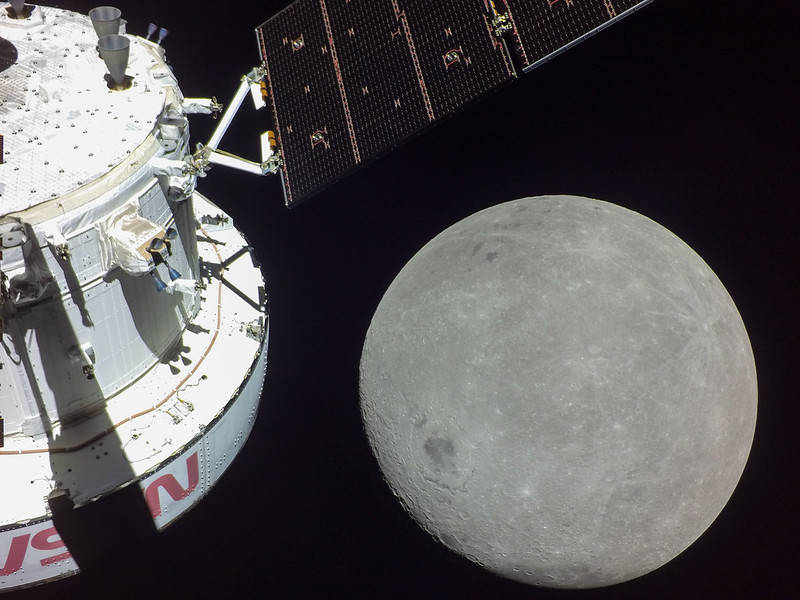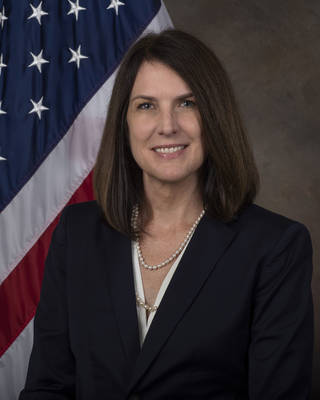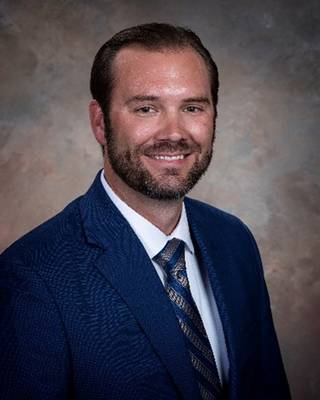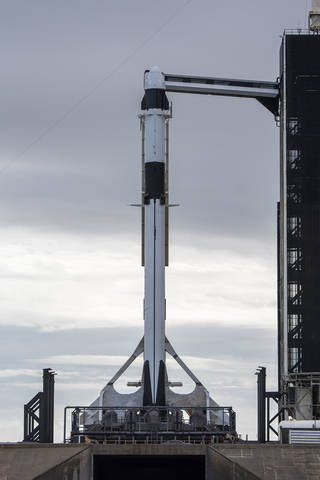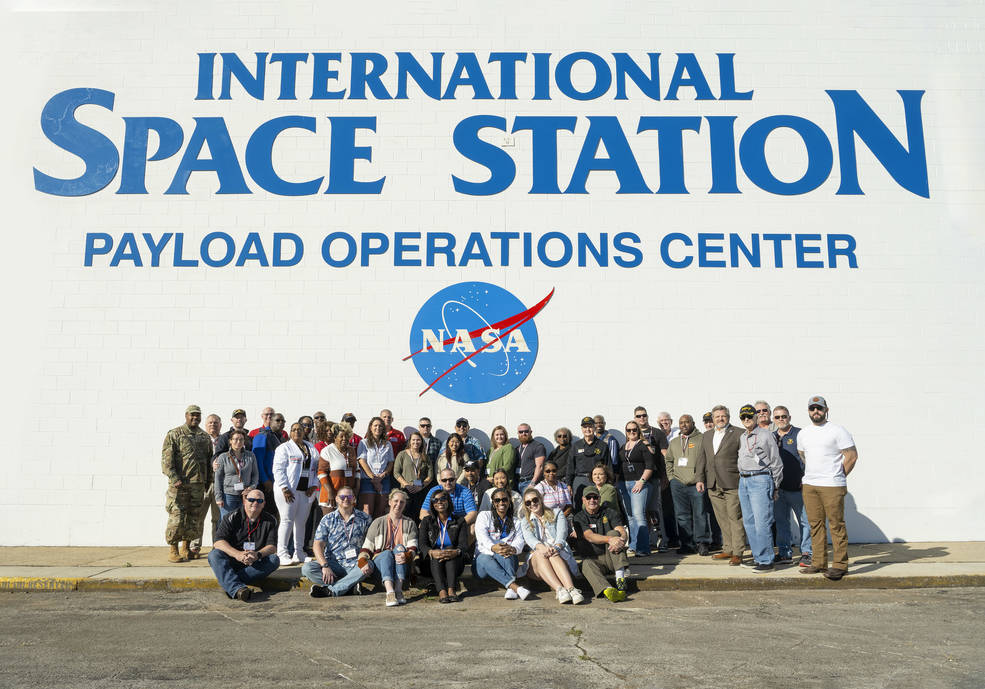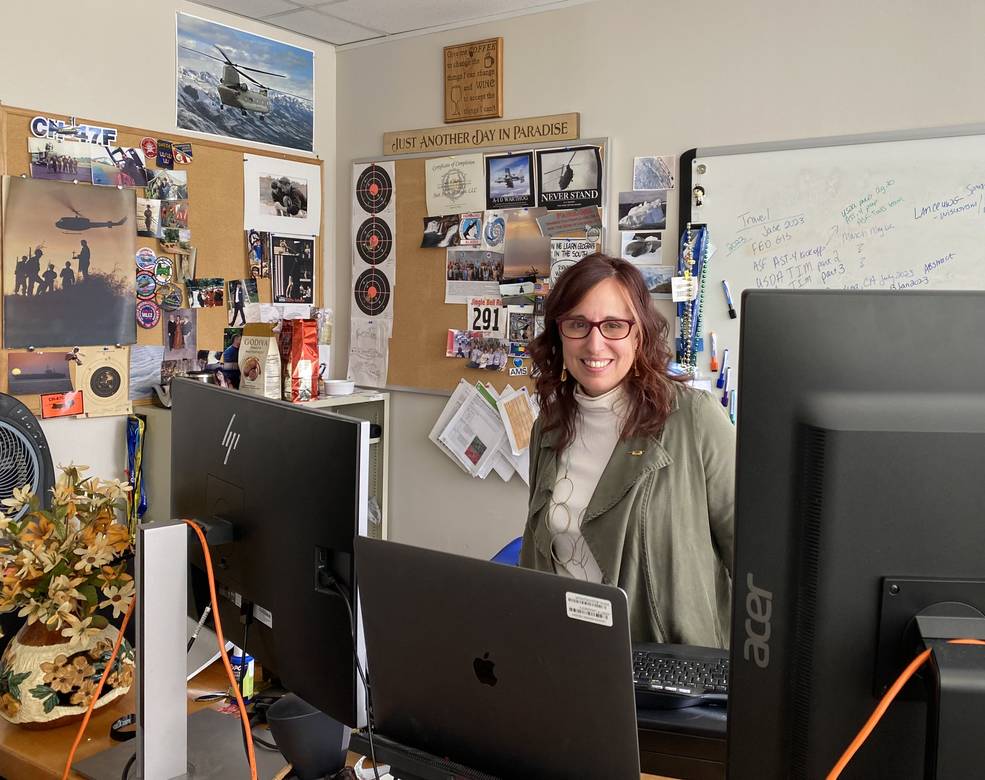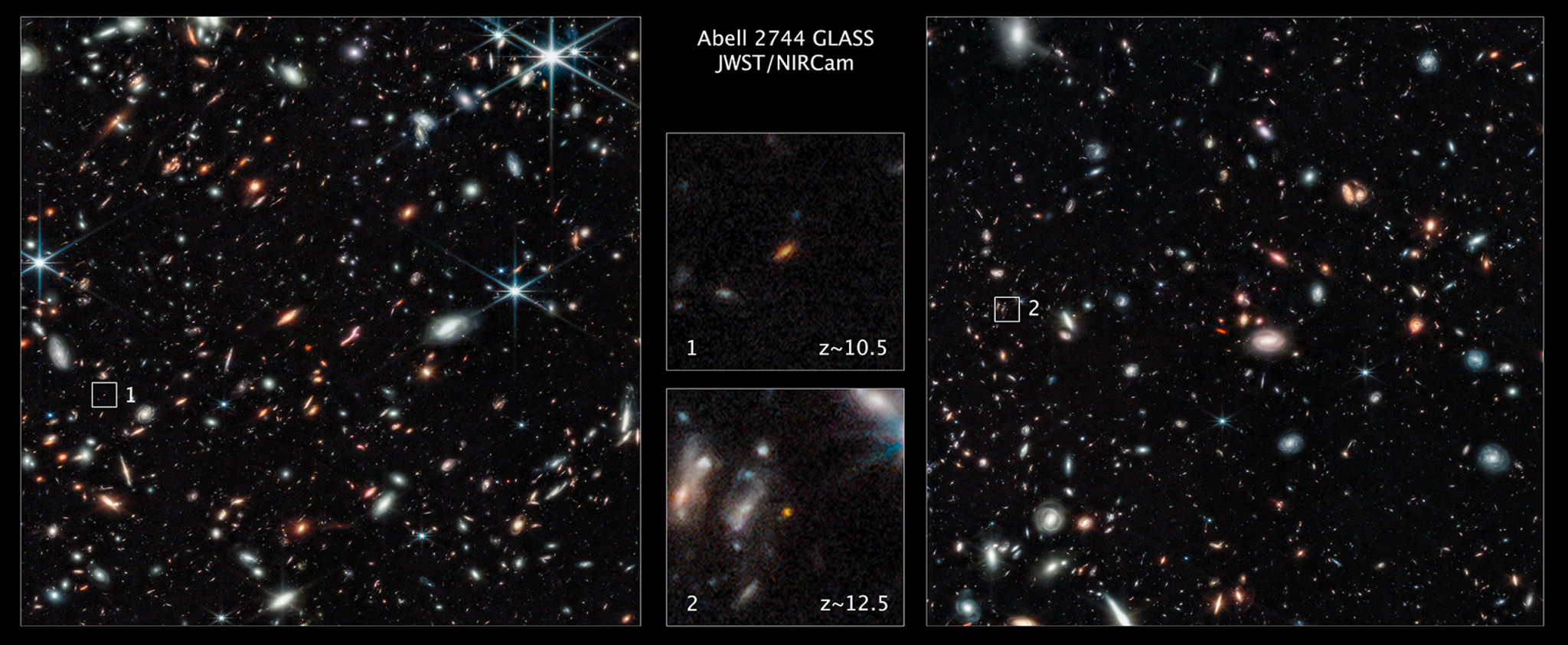The Marshall Star for November 23, 2022.
In This Week’s Star
- Artemis I: Orion Performs Lunar Flyby, Closest Outbound Approach
- Marshall Names New Center Executive Officer, Center Strategy Lead
- NASA Awards Contract for NASA Financial Support Services
- 50 States: Materials for Artemis
- NASA, SpaceX Now Targeting Nov. 26 for CRS-26 Launch
- Heroes Week Tour Visits Marshall
- Research Scientist Lori Schultz Unafraid of Change
- NASA’s Webb Draws Back Curtain on Universe’s Early Galaxies
- LOFTID Inflatable Heat Shield Test a Success, Early Results Show
Artemis I: Orion Performs Lunar Flyby, Closest Outbound Approach
On its sixth day into the Artemis I mission Nov. 21, Orion successfully completed its fourth orbital trajectory correction burn using the auxiliary engines at 1:44 a.m. CST ahead the first of two maneuvers required to enter a distant retrograde orbit around the Moon. The first three trajectory correction burns provided an opportunity to fire all three thruster types on Orion with the first using the large orbital maneuvering system engine, the second using the small reaction control system thrusters, and the third using the medium-sized auxiliary engines.
Orion completed the outbound powered flyby at 6:44 a.m., passing about 81 miles above the surface at 6:57 a.m. The spacecraft speed increased from 2,128 mph before the burn to 5,102 mph after the burn. Shortly after the outbound flyby burn, the space craft passed about 1,400 miles above the Apollo 11 landing site at Tranquility Base at 7:37 a.m. Orion later flew over the Apollo 14 site at about 6,000 miles in altitude and then over the Apollo 12 site at an altitude of about 7,700 miles.
“The mission continues to proceed as we had planned, and the ground systems, our operations teams, and the Orion spacecraft continue to exceed expectations, and we continue to learn along the way about this new, deep-space spacecraft,” said Mike Sarafin, Artemis I mission manager, in a Nov. 21 briefing at Johnson Space Center.
Orion will enter distant retrograde orbit beyond the Moon on Nov. 25 with the second maneuver, called the distant retrograde orbit insertion burn. The orbit is “distant” in the sense that it’s at a high altitude from the surface of the Moon, and it’s “retrograde” because Orion will travel around the Moon opposite the direction the Moon travels around Earth. This orbit provides a highly stable orbit where little fuel is required to stay for an extended trip in deep space to put Orion’s systems to the test in an extreme environment far from Earth.
Orion will travel about 57,287 miles beyond the Moon at its farthest point from the Moon on Nov. 25, pass the record set by Apollo 13 for the farthest distance traveled by a spacecraft designed for humans at 248,655 miles from Earth on Nov. 26, and reach its maximum distance from Earth of 268,552 miles on Nov. 28.
As of Nov. 21, a total of 3,715.7 pounds of propellant has been used, 76.2 pounds less than prelaunch expected values. There are 2,112.2 pounds of margin available over what is planned for use during the mission, an increase of 201.7 pounds from prelaunch expected values.
Just after 2:45 p.m. CST on Nov. 21, Orion had traveled 216,842 miles from Earth and was 13,444 miles from the Moon, cruising at 3,489 miles per hour.
For Artemis updates, visit here.
Follow along and track Orion via the Artemis Real-Time Orbit Website, or AROW, and watch live footage from the spacecraft. You can also find the latest images from Orion on the Johnson Space Center Flickr account.
Marshall Names New Center Executive Officer, Center Strategy Lead
Kathy Byars has been named center executive officer and Jeramie Broadway center strategy lead at NASA’s Marshall Space Flight Center.
As center executive officer, Byars will lead the overall office management and operations within the director’s office, providing integration and coordination of center-wide actions and serving as Marshall’s chief of staff.
As center strategy lead, Broadway will lead and implement the director’s strategic vision, leveraging and integrating Marshall’s strategic business units, in coordination and collaboration with all center organizations, to ensure alignment with the agency’s strategic priorities.
Byars most recently served from 2020-2022 as integration manager for the Payload and Mission Operations Division (PMOD) of Marshall’s Human Exploration Development and Operations Office. In this capacity, she led Commercial Low Earth Orbit activities, supporting the first private astronaut mission. She also oversaw the International Space Station Transition Team, supporting NASA’s Commercial Crew Program, partnering with other NASA centers and commercial companies, and promoting the facilities, services, and expertise for which Marshall is known across government and the space industry. She also served from 2021-2022 as branch manager of the PMOD Payload and Crew Operations Branch, delivering innovative science operations support for space station operations controllers, product developers, payload safety personnel, and crew systems integrators.
Byars began her aerospace career as a U.S. Air Force officer assigned to the 1st Manned Spaceflight Control Squadron, supporting Space Shuttle and space station programs at NASA’s Johnson Space Center. She then became an Air Force pilot, flying T-38 Talon and C-130 Hercules aircraft, before continuing her flying career as a commercial airline pilot. She rejoined the space station program team in 2016 as a PMOD operations controller. In 2018, Byars was selected as a space station payload operations director. In that role, she chaired the PMOD training panel and was the flight lead payload operations director for the NG-12 and SpX-19 missions. She also was assistant payload operations manager for Increment 64B.
Byars was born in Selma, Alabama. She earned a bachelor’s degree in aeronautical and astronautical engineering in 1986 from Purdue University in West Lafayette, Indiana. She and her husband, Jerry, have two children, Erin and John.
Before assuming his new role, Broadway was senior technical assistant to the Marshall Associate Director, Technical, from September 2021 to October 2022. In that capacity, he supported the development, coordination, and implementation of Marshall strategic planning and partnering within NASA and across industry and academia. Prior to that detail, he was the assistant manager of Marshall’s Partnerships and Formulation Office, providing strategic planning and business development support and creating new partnering and new mission opportunities for the center.
Broadway, who joined NASA in 2008, began his career in Marshall’s Materials and Processes Laboratory, supporting and leading production operations for the Ares I and Space Launch System program. Over the years, he served as project engineer or deputy project manager for a variety of work, including the Nuclear Cryogenic Propulsion Stage Project, for which he led development of advanced, high-temperature nuclear fuel materials. He was assistant chief engineer for launch vehicles for NASA’s Commercial Crew Program and assistant chief engineer for NASA’s Technology Demonstration Mission Program, managed for the agency at Marshall.
A native of Dallas, Texas, and a U.S. Air Force veteran, Broadway earned a bachelor’s degree in mechanical engineering in 2008 from the University of North Dakota in Grand Forks, and a master’s degree in aerospace engineering in 2011 from the University of Alabama in Tuscaloosa. He and his wife, Sherrie Beal Broadway, have four children: Kaylen, Ellie, Carsen, and Nolan.
NASA Awards Contract for NASA Financial Support Services
NASA recently awarded the NASA Financial Support Services contract to MM Technologies LLC (MMT) of Huntsville to provide financial support and related services at the agency’s Armstrong Flight Research Center, Ames Research Center, Glenn Research Center, Kennedy Space Center, Johnson Space Center, Marshall Space Flight Center, Stennis Space Center, and NASA centers as needed.
This performance-based indefinite-delivery/indefinite-quantity contract with firm-fixed-price and cost-plus-fixed-fee task orders has a maximum potential value of $553.7 million. The contract begins Dec. 1, with a 90-day phase-in period, followed by a two-year base period, three two-year option periods, and a six-month Option to Extend Services period that may be exercised at NASA’s discretion.
Under this small business, set-aside contract, MMT will be responsible for providing financial services in support of NASA’s missions, programs, projects, centers, and organizational offices. Work elements to be performed under this contract include resource/financial management, accounting, quality assurance services, travel and conference administration, financial management business information services, and special financial analyses.
50 States: Materials for Artemis
From titanium to cloth, thousands of materials are used to build Artemis. Check out some of the companies across the US that supply those materials. (NASA)
NASA, SpaceX Now Targeting Nov. 26 for CRS-26 Launch
Due to poor weather conditions in the area along Florida’s Space Coast for the Nov. 22 planned launch of SpaceX’s 26th commercial resupply services mission to the International Space Station, SpaceX and NASA now are targeting liftoff for 1:20 p.m. CST Nov. 26 from the agency’s Kennedy Space Center. Launch coverage will begin at 1 p.m. CST on NASA TV, the agency’s website, and the NASA app.
A launch Nov. 26 would lead to docking Nov. 27 for the Dragon to deliver important research, crew supplies, and hardware to the crew aboard the orbiting laboratory. Docking coverage will begin at 5 a.m. CST with the spacecraft planned to arrive at the space station around 6:30 a.m. CST. The spacecraft is expected to spend about a month attached to the orbiting outpost before it returns to Earth with research and return cargo, splashing down off the coast of Florida.
The Dragon spacecraft will deliver a variety of NASA investigations, including the next pair of International Space Station Roll Out Solar Arrays (iROSAs), which will augment power to the orbiting laboratory. The spacecraft also will carry a study to grow dwarf tomatoes to help create a continuous fresh-food production system in space, as well as an experiment that tests an on-demand method to create specific quantities of key nutrients.
The Payload Operations Center at NASA’s Marshall Space Flight Center houses the International Space Station Payload Operations Integration Center.
Learn more about station activities by following the space station blog, @space_station and @ISS_Research on Twitter as well as the ISS Facebook and ISS Instagram accounts.
Heroes Week Tour Visits Marshall
A group participating in the Heroes Week Tour at NASA’s Marshall Space Flight Center pauses for a photo at the Payload Operations Center on Nov. 9. As part of the Heroes Week tour, visitors also saw the Laboratory Training Complex, Environmental Control & Life Support System (ECLSS), and Friction Stir Welding locations. (NASA/Charles E. Beason)
Research Scientist Lori Schultz Unafraid of Change
(This is the ninth in a series of profiles on early career scientists in the Earth Science Branch at NASA’s Marshall Space Flight Center.)
By Dauna Coulter
“I grew up as part of a large family,” says Lori Schultz. “Mom, to keep peace about our differences, told us about how the angels tried to guide children into different lines to receive gifts and talents before they were born. She said that children who wanted specific gifts chose to stay in a certain line, losing out on their chance at being blessed with other skills.”
Schultz, a research scientist at NASA’s Marshall Space Flight Center, believes this was her mom’s way of encouraging tolerance of differences and openness to possibilities.
Her mom would be proud of her.
Schultz thinks outside the box. She has taken a novel approach to all aspects of her existence, pursuing goals with vigor, overcoming obstacles, and disregarding stereotypes. And she’s not afraid to change course. In fact, that’s how she ended up at NASA working in the disasters program.
“When I was young, I fell in love with airplanes,” Schultz explained. “I sketched them all the time and wanted to fly and work on them. My grandad was a builder, and my dad, brothers, and uncle were all in construction trades. I grew up with that mindset.”
After high school, when the college aviation program proved too costly, she joined the U.S. Army instead.
Although Schultz didn’t get to be a pilot, she did ace most everything she tried.
“I wanted to fly helicopters, so I wouldn’t join until they guaranteed me that job,” she said. “I became a flight mechanic on a Chinook helicopter. I was always baffled that people thought women couldn’t be helicopter mechanics. Later, I graduated to crew chief and then to flight engineer.”
Schultz met her husband when they worked together at Fort Bragg, North Carolina. A few years later, while the couple was stationed in Italy, their son was born.
Her job, though she loved it, was physically tough. But the deal-breaker was that it kept her away from her son too much. So, she left the Army and reinvented her career.
With a strong aptitude for math, and a drive to understand how things work, Schultz earned a bachelor’s degree in physics at Austin Peay State University in Tennessee.
“At 28 I had to learn how to be a student again – how to study,” she said. “I even had to take some remedial courses to refresh what I had learned 10 years ago.”
On a research trip to the University of Alabama in Huntsville, she became intrigued with the work underway there with NASA in applied sciences. She enrolled in UAH’s atmospheric science program and earned a master’s degree. Schultz worked for UAH before joining NASA, where she is now a center coordinator for the NASA Applied Sciences Disasters program area.
She also belongs to a research team that uses remote sensing to provide imagery after floods. She has found her military experience useful.
“I was deployed in Hurricane Mitch in Central America when I was in the Army,” she noted. “My time on the ground there proved helpful years later when I provided satellite imagery for flood mapping after hurricanes in the same area.”
Schultz emphasized that with disasters, the initial conditions differ each time.
“It’s an ever-changing environment,” she explained. “Something that’s successful one time may not work the next. We have to be innovative and use old datasets in new ways. It’s not the standard NASA science approach, where you perform research, tests, and then write a paper about doing something new. That process takes an average of three years, and we have to act now, using what we have.”
People skills are also involved.
“We should put ourselves in the shoes of the people we help,” she said. “We shouldn’t come across as telling them how to do their jobs. It’s a matter of translating versus training. We don’t want to imply that they’re not as smart we are. We can learn from them.”
Learning is really Schultz’s approach in general.
“I want to learn daily,” Schultz said. “I never want to think I know everything. We should give ourselves an honest assessment each day, asking ourselves what we did right and wrong. Sometimes we fail. But we learn so much more from failures than from successes.”
Her varied successes are in fact not a source of pride to her. But one thing is.
“I am most proud that my son is so much better than me,” she said.
She’s a flight mechanic, research scientist, disaster mitigator, and good at all of it. Schultz must be an ace mom too.
Coulter, a Media Fusion employee, supports Marshall’s Office of Strategic Analysis & Communications.
NASA’s Webb Draws Back Curtain on Universe’s Early Galaxies
A few days after officially starting science operations, NASA’s James Webb Space Telescope (JWST) propelled astronomers into a realm of early galaxies, previously hidden beyond the grasp of all other telescopes until now.
“Everything we see is new. Webb is showing us that there’s a very rich universe beyond what we imagined,” said Tommaso Treu, principal investigator on one of the Webb programs who is based at the University of California at Los Angles. “Once again the universe has surprised us. These early galaxies are very unusual in many ways.”
Two research papers, led by Marco Castellano of the National Institute for Astrophysics in Rome, Italy, and Rohan Naidu of the Harvard-Smithsonian Center for Astrophysics and the Massachusetts Institute of Technology in Cambridge, Massachusetts, have been published in the Astrophysical Journal Letters.
These initial findings are from a broader Webb research initiative involving two Early Release Science (ERS) programs: the Grism Lens-Amplified Survey from Space (GLASS), and the Cosmic Evolution Early Release Science Survey (CEERS).
With just four days of analysis, researchers found two exceptionally bright galaxies in the GLASS-JWST images. These galaxies existed approximately 450 and 350 million years after the big bang (with a redshift of approximately 10.5 and 12.5, respectively), though future spectroscopic measurements with Webb will help confirm.
“With Webb, we were amazed to find the most distant starlight that anyone had ever seen, just days after Webb released its first data,” said Naidu of the more distant GLASS galaxy, referred to as GLASS-z12, which is believed to date back to 350 million years after big bang. The previous record holder is galaxy GN-z11, which existed 400 million years after the big bang (redshift 11.1), was identified in 2016 by Hubble and Keck Observatory in deep-sky programs.
“Based on all the predictions, we thought we had to search a much bigger volume of space to find such galaxies,” said Castellano.
“These observations just make your head explode. This is a whole new chapter in astronomy. It’s like an archaeological dig, and suddenly you find a lost city or something you didn’t know about. It’s just staggering,” added Paola Santini, fourth author of the Castellano et al. GLASS-JWST paper.
“While the distances of these early sources still need to be confirmed with spectroscopy, their extreme brightness is a real puzzle, challenging our understanding of galaxy formation,” noted Pascal Oesch at the University of Geneva in Switzerland, second author of the Naidu et al. paper.
The Webb observations nudge astronomers toward a consensus that an unusual number of galaxies in the early universe were much brighter than expected. This will make it easier for Webb to find even more early galaxies in subsequent deep sky surveys, say researchers.
“We’ve nailed something that is incredibly fascinating. These galaxies would have had started coming together maybe just 100 million years after the big bang. Nobody expected that the dark ages would have ended so early,” said Garth Illingworth of the University of California at Santa Cruz, a member of the Naidu/Oesch team. “The primal universe would have been just one hundredth its current age. It’s a sliver of time in the 13.8 billion-year-old evolving cosmos.”
Erica Nelson of the University of Colorado, a member of the Naidu/Oesch team, noted that “our team was struck by being able to measure the shapes of these first galaxies; their calm, orderly disks question our understanding of how the first galaxies formed in the crowded, chaotic early universe.” This remarkable discovery of compact disks at such early times was only possible because of Webb’s much sharper images, in infrared light, compared to Hubble.
“These galaxies are very different than the Milky Way or other big galaxies we see around us today,” said Treu.
Illingworth emphasized the two bright galaxies found by these teams have a lot of light. He said one option is that they could have been very massive, with lots of low-mass stars, like later galaxies. Alternatively, they could be much less massive, consisting of far fewer extraordinarily bright stars, known as Population III stars. Long theorized, they would be the first stars ever born, blazing at blistering temperatures and made up only of primordial hydrogen and helium – before stars could later cook up heavier elements in their nuclear fusion furnaces. No such extremely hot, primordial stars are seen in the local universe.
“Indeed, the farthest source is very compact, and its colors seem to indicate that its stellar population is particularly devoid of heavy elements and could even contain some Population III stars. Only Webb spectra will tell,” said Adriano Fontana, second author of the Castellano et al. paper and a member of the GLASS-JWST team.
Present Webb distance estimates of these two galaxies are based on measuring their infrared colors. Eventually, follow-up spectroscopy measurements showing how light has been stretched in the expanding universe will provide independent verification of these cosmic yardstick measurements.
The James Webb Space Telescope is the world’s premier space science observatory. Webb will solve mysteries in our solar system, look beyond to distant worlds around other stars, and probe the mysterious structures and origins of universe and our place in it. Webb is an international program led by NASA with its partners, ESA (European Space Agency) and CSA (Canadian Space Agency). Webb launched Dec. 25, 2021, on an Ariane 5 rocket from Europe’s Spaceport in French Guiana, South America.
NASA Headquarters oversees the mission for the agency’s Science Mission Directorate. NASA’s Goddard Space Flight Center manages Webb for the agency and oversees work on the mission performed by the Space Telescope Science Institute, Northrop Grumman, and other mission partners. In addition to Goddard, several NASA centers contributed to the project, including the agency’s Johnson Space Center, Jet Propulsion Laboratory, Marshall Space Flight Center, Ames Research Center, and others.
Read more about Marshall’s work for the mission here.
LOFTID Inflatable Heat Shield Test a Success, Early Results Show
NASA’s Low-Earth Orbit Flight Test of an Inflatable Decelerator, or LOFTID, launched Nov. 10 to demonstrate inflatable heat shield technology that could be key to landing humans on Mars.
About an hour after launch on a United Launch Alliance Atlas V rocket, LOFTD inflated and deployed in space. After being released by the Centaur upper stage, the heat shield, or aeroshell, began its perilous re-entry journey through Earth’s atmosphere, entering the atmosphere at more than 18,000 miles per hour. LOFTID created enough drag to slow to less than 80 miles per hour by the end of its demonstration. At this point, LOFTID’s onboard parachutes deployed, carrying the heat shield to a gentle splashdown in the Pacific Ocean.
The team recovered the LOFTID aeroshell within a few hours, and early indications show that the demonstration was successful. In addition to achieving its primary objective of surviving the intense dynamic pressure and heating of re-entry, it appears that the aft side of the heat shield – opposite LOFTID’s nose – was well protected from the re-entry environment. This suggests that inflatable aeroshells can keep payloads safe during atmospheric entry.
Full study of LOFTID’s performance is expected to take about a year. The results of the LOFTID demonstration will inform future designs for inflatable heat shields that could be used to land heavier payloads on worlds with atmospheres, including Mars, Venus, Saturn’s moon Titan, and Earth.
The LOFTID project is managed and funded through NASA’s Technology Demonstration Missions program, part of the agency’s Space Technology Mission Directorate. The project is led by NASA’s Langley Research Center, with contributions from NASA’s Ames Research Center, Marshall Space Flight Center, and Armstrong Flight Research Center.
View a video about NASA successfully testing the LOFTID Inflatable Heat Shield:


























